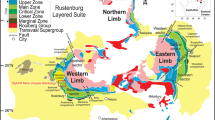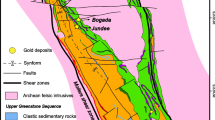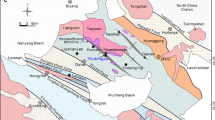Abstract.
The Crixás Goldfield is a part of the Tocantins province and consists of a ~2.9 Ga Archean granite–greenstone terrane. The gold field contains one large deposit (Mina III, 65 tons Au) and several smaller occurrences, which are structurally controlled by regional shear zones that are either thrust or strike-slip faults. The deposits can be classified as auriferous massive sulfide (pyrrhotite + arsenopyrite) hosted ores within sulfidized banded iron formations, auriferous quartz veins, and disseminated gold ores in carbonaceous schists. On a more local scale, the ore bodies coincide with dilation zones surrounded by hydrothermal alteration haloes of various widths within carbonaceous schists, iron formations, and metabasalts. Hydrothermal alteration related to deposits within thrust faults consists of sulfidization and carbonatization, whereas, within strike-slip faults, propylitic, potassic, and sericitic alteration zones occur in concentric haloes. In both cases, quartz veins and veinlets may be abundant. Absolute ages of mineralization are uncertain, but structural data suggest multiple events probably occurred during Archean, Paleoproterozoic and Neoproterozoic tectonic events.
Similar content being viewed by others
Author information
Authors and Affiliations
Additional information
Electronic Publication
Rights and permissions
About this article
Cite this article
Jost, H., de Tarso Ferro de Oliveira Fortes, P. Gold deposits and occurrences of the Crixás Goldfield, central Brazil. Min Dep 36, 358–376 (2001). https://doi.org/10.1007/s001260100171
Received:
Accepted:
Published:
Issue Date:
DOI: https://doi.org/10.1007/s001260100171




